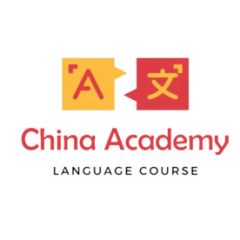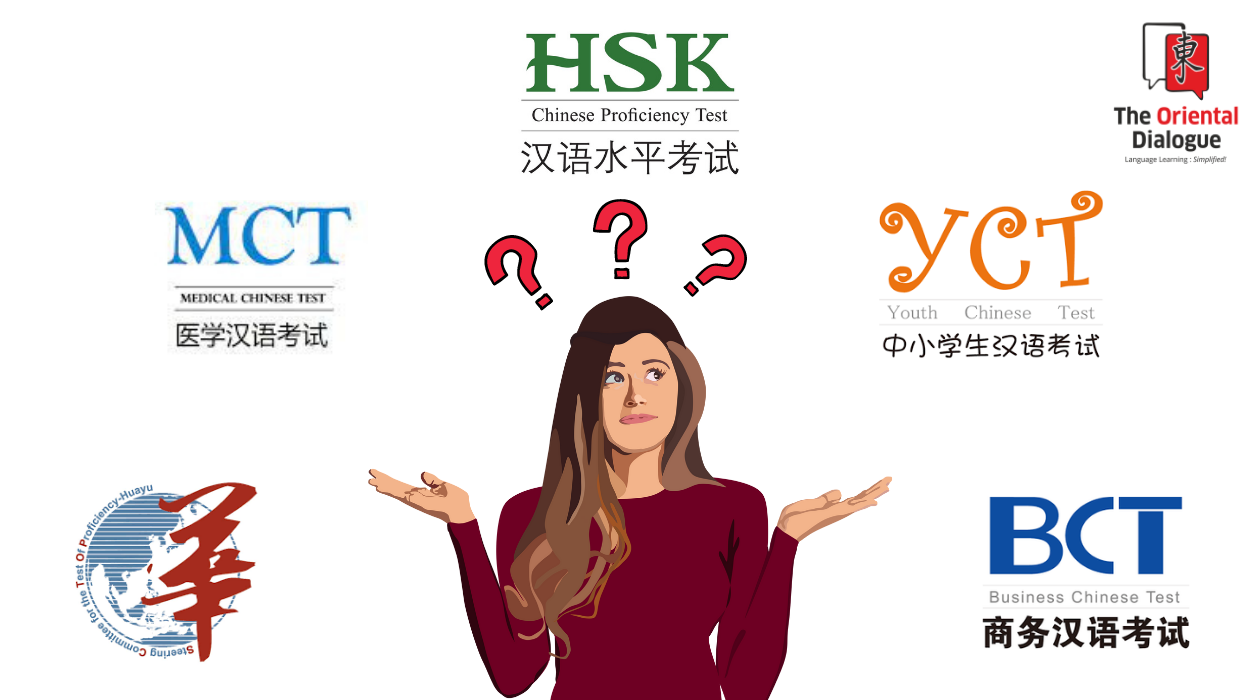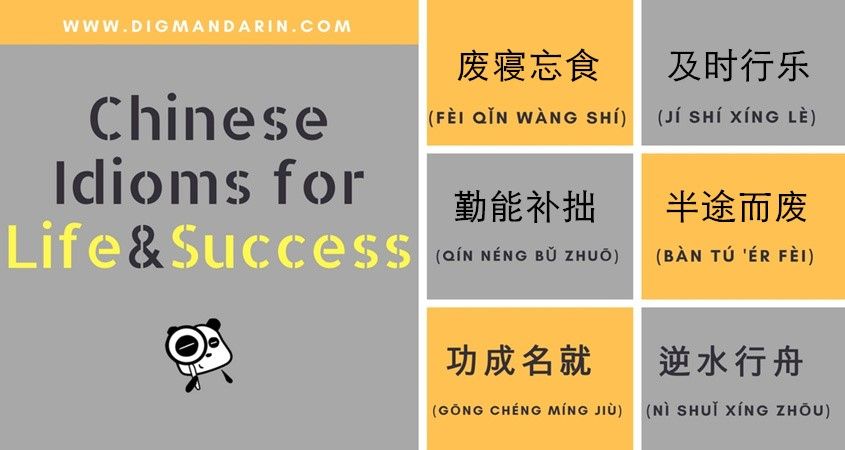When it comes to entering a professional Chinese business setting, it is crucial to have sound knowledge of the language used in business contexts. Ordinary daily expressions will fall short. This is where the Business Chinese Test (BCT) comes into play. Despite the abundance of study materials available for other Chinese language tests, such as the HSK or YCT, information on the BCT is relatively scarce. So, we have created this guide to give you a comprehensive overview of the BCT and help you prepare for success in your Chinese business endeavors.
- What is the BCT?
- Why should I take the BCT?
- BCT levels and content
- The BCT(A) structure
- The BCT(B) structure
- The BCT (Oral iBT) structure
- BCT, HSK and YCT
- How to register for the BCT?
- 2023 BCT dates and registration deadlines
- BCT passing scores and report
- How to prepare for the BCT?
- Conclusion
What is the BCT?
The Business Chinese Test (BCT) is an internationally standardized test designed to assess the Chinese language proficiency of non-native Chinese speakers in business-related communications or working environments. The BCT focuses on real business settings, and its content pertains more to practical language use, rather than professional business knowledge.
Why should I take the BCT?
As a standardized test, the BCT can provide several intuitive benefits, as follows:
- Improving employment opportunities: If you plan to work in a Chinese-speaking business environment, taking the BCT can help you stand out as a qualified candidate. More and more companies and organizations require Chinese language proficiency and may prefer or require candidates with a BCT certificate.
- Demonstrating proficiency in Chinese and business communication: The BCT assesses practical language skills necessary for conducting business, including listening, speaking, reading, and writing. By taking the test and achieving a high score, you can demonstrate both your language proficiency and your ability to communicate effectively in a business setting.
- Improving business relationships: In preparation for doing business with Chinese companies or clients, taking the BCT can help you better understand Chinese business practices, communication styles, and cultural norms. This can not only enhance your language skills and cultural awareness, but also help you more easily engage with Chinese people, ultimately building stronger relationships.
BCT levels and content
The BCT is made up of two independent parts: a writing test and a speaking test. The writing test is divided into two levels: the BCT (A) and the BCT (B).
The BCT(A) Structure
The BCT (A) is conducted on paper or online. It includes three sections: listening, reading, and writing. The test consists of 70 questions in total and is based on a reference vocabulary of 600 words.
| Section | Questions | Time (minutes) | ||
| Listening | Part 1 | 10 | 30 | about 20 |
| Part 2 | 10 | |||
| Part 3 | 10 | |||
| Fill out your answer sheet after listening | 5 | |||
| Reading | Part 1 | 10 | 30 | 30 |
| Part 2 | 20 | |||
| Writing | / | 10 | 10 | |
| Total | / | 70 | about 65 | |
*The entire test will take approximately 70 minutes, including 5 minutes for filling out personal information.
Description:
- Listening:
Part 1: 10 questions. Each clip is played twice. Test takers should determine whether the words or phrases heard match the pictures provided.
Part 2: 10 questions. Each clip is played twice. Test takers will listen to a sentence and should then choose the corresponding picture from three options. Part 3: 10 questions. Each clip is played twice. Test takers will listen to a short dialogue and should then choose the corresponding answer from three options.
- Reading:
Part 1: 10 questions. For the first 5 questions, test takers are provided with a few sentences or a short dialogue, and they should choose the correct answer to complete the sentence. For the remaining 5 questions, there are 5 blanks in a chart or short essay, and test takers should choose the correct options to fill them.
Part 2: 20 questions. Test takers will be provided with reading materials, such as pictures, charts, short paragraphs, or articles. Each example will have one to three corresponding questions. Each question will have three answer options to choose from.
- Writing:
10 questions. Test takers should write the correct Chinese characters based on the Pinyin provided in each sentence.
The BCT(B) structure
BCT (B) is conducted on paper or online. It includes three sections: listening, reading, and writing. It consists of 92 questions in total and is based on a reference vocabulary of 4,000 words.
| Section | Questions | Time (minutes) | ||
| Listening | Part 1 | 20 | 50 | about 35 |
| Part 2 | 15 | |||
| Part 3 | 15 | |||
| Fill out your answer sheet after listening | 5 | |||
| Reading | Part 1 | 20 | 40 | 60 |
| Part 2 | 10 | |||
| Part 3 | 10 | |||
| Writing | / | 2 | 40 | |
| Total | / | 92 | about 140 | |
* The entire test takes approximately 145 minutes, including 5 minutes for filling out personal information.
Description:
- Listening:
Part 1: 20 questions. Each question is based on a two-sentence dialogue, which is played once. Test takers should choose the correct answer from four options.
Part 2: 15 questions. Each question is based on a four-sentence dialogue, which is played once. Test takers should choose the correct answer from four options.
Part 3: 15 questions. There are five dialogues, each played once. After each dialogue, several questions will be provided, and test takers should choose the corresponding answer from four options.
- Reading:
Part 1: 20 questions. Test takers will be provided with reading material, such as a picture, chart, paragraph, or article. Each example will have several questions. Test takers should choose the correct answer from four options for each question.
Part 2: 10 questions. This section contains two short articles with five blanks each. Test takers should choose the correct answers based on the context from seven sentences provided under each article.
Part 3: 10 questions. Four examples and several questions or sentences will be provided. Test takers should match the questions or sentences with the corresponding materials.
- Writing:
2 questions. In the first part, test takers must write a short article of at least 80 characters according to the provided materials and requirements. In the second part, test takers must write a short article of at least 150 characters based on the provided materials and requirements.
The BCT (Oral iBT) Structure
The BCT (Oral iBT) is a language proficiency test designed to evaluate the speaking ability of non-native speakers of Chinese. It is conducted entirely online and is based on a reference vocabulary of 4000 words.
Test takers are provided with a detailed report of their speaking proficiency, which can be used to assess their language skills for academic, professional, or personal purposes.
| Section | Questions | Time (minutes) |
| Adjustment before test | about 5 | |
| Part 1 | 4 | 2 |
| Part 2 | 4 | 2 |
| Part 3 | 3 | 5 |
| Part 4 | 3 | 5 |
| Part 5 | 1 | 6 |
| Total | 15 | about 25 |
Description:
Part 1: 4 questions. Each clip can be heard once, with an additional opportunity to rehear. For each clip, there is a question and a corresponding picture. Test takers should answer the question based on the picture.
Part 2: 4 questions. Each clip can be heard once, with an additional opportunity to rehear. Test takers should answer each question according to the requirements of each clip.
Part 3: 3 questions. Each clipcan be heard once, with an additional opportunity to rehear. For each clip, there is a situational illustration and a requirement or question, along with a picture. Test takers should answer based on the picture.
Part 4: 3 questions. Each clip can be heard once, with an additional opportunity to rehear. For each clip, there is a background illustration and a requirement or question. Test takers should answer based on the requirements.
Part 5: 1 question. It can be heard once, with an additional opportunity to rehear. For this part, there is a background illustration and a requirement or question, along with four pictures. Test takers should answer based on these pictures.
BCT, HSK and YCT
This information is a helpful reference for individuals planning to take the BCT test. The BCT levels align with the HSK and YCT levels as follows:
| BCT | HSK | YCT | Vocabulary |
| YCT 1 | 80 | ||
| BCT(A) | HSK 1 | YCT 2 | 150 |
| HSK 2 | YCT 3 | 300 | |
| HSK 3 | YCT 4 | 600 | |
| BCT(B) | HSK 4 | 1200 | |
| HSK 5 | 2500 | ||
| HSK 6 | Over 5000 |
* the BCT(A) is aimed at the elementary level, while the BCT(B) is oriented towards intermediate and advanced levels.
It is important to note that while there is some overlap in the vocabulary between the BCT and HSK/YCT, there are also business-related words that are unique to the BCT and do not appear in any other test.
How to register for the BCT?
Before registering for the BCT, it is important to know the test date and location. You can visit the official website to check the updated schedule and location of testing centers where the BCT will be conducted.
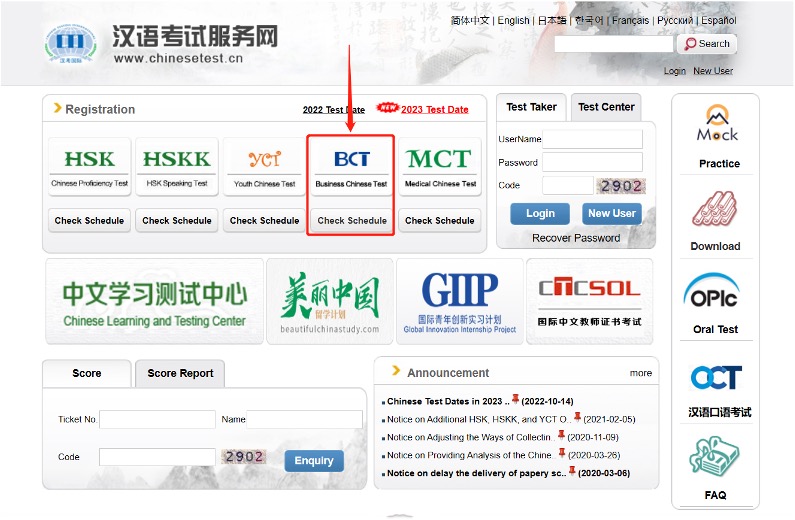
2023 BCT dates and registration deadlines
| Test Date | Form | Registration Deadline | |
| Paper | Internet | ||
| 4th, February | PBT+IBT | 8th, January | 25th, January |
| 15th, April | PBT+IBT | 19th, March | 5th, April |
| 18th, June | PBT+IBT | 22nd , May | 8th, June |
| 5th, August | PBT+IBT | 9th, July | 26th, July |
| 12th, November | PBT+IBT | 16th, October | 2nd, November |
There are two ways to register:
- Register in a local test center according to its own requirements.
- Register online on the official website as follows:

Please note that:
- Online registration is managed by local test centers. In some cases, this function is not available and visiting the center in person to register is the only option
- The test fee varies in different locations
- Keep your registration ticket safe for future use
- Contact your local test center ahead of time to obtain precise details
BCT passing scores and report
There is no exact passing score for the BCT, but test takers will receive a report that shows their score for each skill and total score, along with a corresponding description of their capabilities. The score report is usually available within a month, although in some places it may take longer.
For the BCT(A) and BCT(B), the total maximum score is 300.
BCT(A) Score Structure
| Listening | Reading | Writing | Total | |
| Items | 30 | 30 | 10 | 70 |
| Full marks | 100 | 100 | 100 | 300 |
BCT(B) Score Structure
| Listening | Reading | Writing | Total | |
| Items | 50 | 40 | 2 | 92 |
| Full marks | 100 | 100 | 100 | 300 |
For the BCT (Oral iBT), the total maximum score is 500.
BCT (Oral iBT) Score Structure
| Part 1 | Part 2 | Part 3 | Part 4 | Part 5 | Total | |
| Items | 4 | 4 | 3 | 3 | 1 | 15 |
| Full marks | 80 | 100 | 120 | 120 | 80 | 500 |
Note that you can check your results on the official website’s homepage by entering your registration ticket number and name.
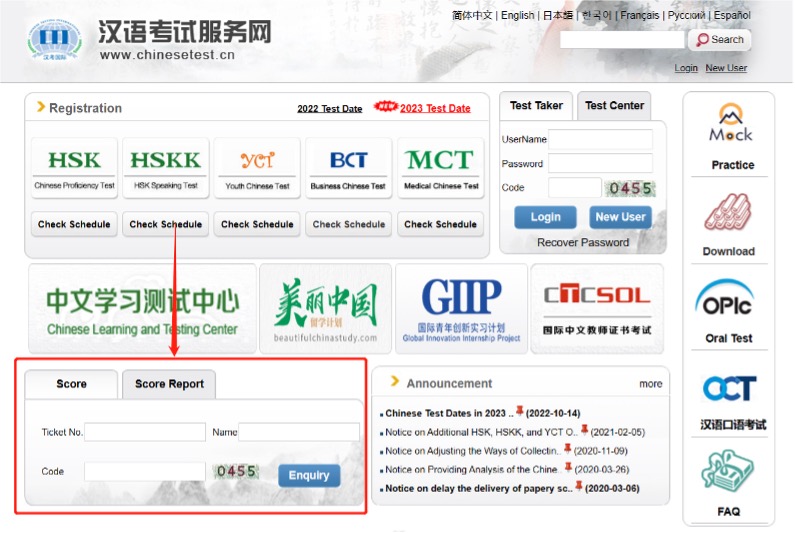
How to prepare for the BCT?
As the building blocks of language, words are crucial for success in an exam like the BCT. To prepare, you should first focus on mastering business-related vocabulary. However, with so many words to learn, it is important to quickly filter out words you already know and focus on unfamiliar words or those with multiple meanings.
To be successful, practice is essential. Once you have mastered the necessary vocabulary, you can try various methods to practice, such as watching Chinese dramas and videos related to business, practicing with Chinese-speaking colleagues, or taking BCT mock exams.
Watching dramas and videos is a particularly effective way to become familiar with Chinese business practices, communication styles, and cultural norms in an engaging and enjoyable way. For those taking the BCT(A) exam, dramas may be too challenging, but there are many short business-related videos online that can help you practice listening and speaking skills.
Here are some Chinse dramas and practice videos to get you started:
- 《理想之城》The Ideal City
- 《玫瑰之战》Rose War
- 《猎场》Game of Hunting
- 高级商务中文 Advanced Business Chinese
- Business Mandarin For Beginners 2019 Part 1
- Business Mandarin for Beginners 2019 Part 2
Since the BCT evaluates language ability in a business setting, practicing what you have learned while at work can be extremely helpful. By being immersed in a business context, you can receive real-time feedback when using new vocabulary and phrases, helping you correct mistakes and reinforcing your understanding of these terms until you have a good grasp of them.
Mock tests are crucial for any exam, as they not only help you become familiar with the structure, style, and question types in advance, but they also provide an opportunity to simulate the exam environment and time constraints. The more you know about BCT, the more comfortable you will be during the actual exam.
Here are two mock tests for the BCT:
- BCT(A) PDF with audio
- BCT(B) PDF with audio
In addition to studying independently, signing up for formal BCT lessons with a professional teacher can be highly beneficial. With an organized course and an experienced guide, you can focus on the areas where you need more help and receive precise feedback on your progress.
Here are some related Business Chinese culture and books for you to prepare:
- Recommended Business Chinese Textbooks For Different Levels
- Top 100 Common Business Chinese Phrases & Expressions
- 12 Tips for Chinese Business Etiquette and Culture
- 12 Essential Phrases to Speak Professional Business Chinese in a Social Setting
- Business Chinese: Essential Mandarin Expressions for Online Meetings
